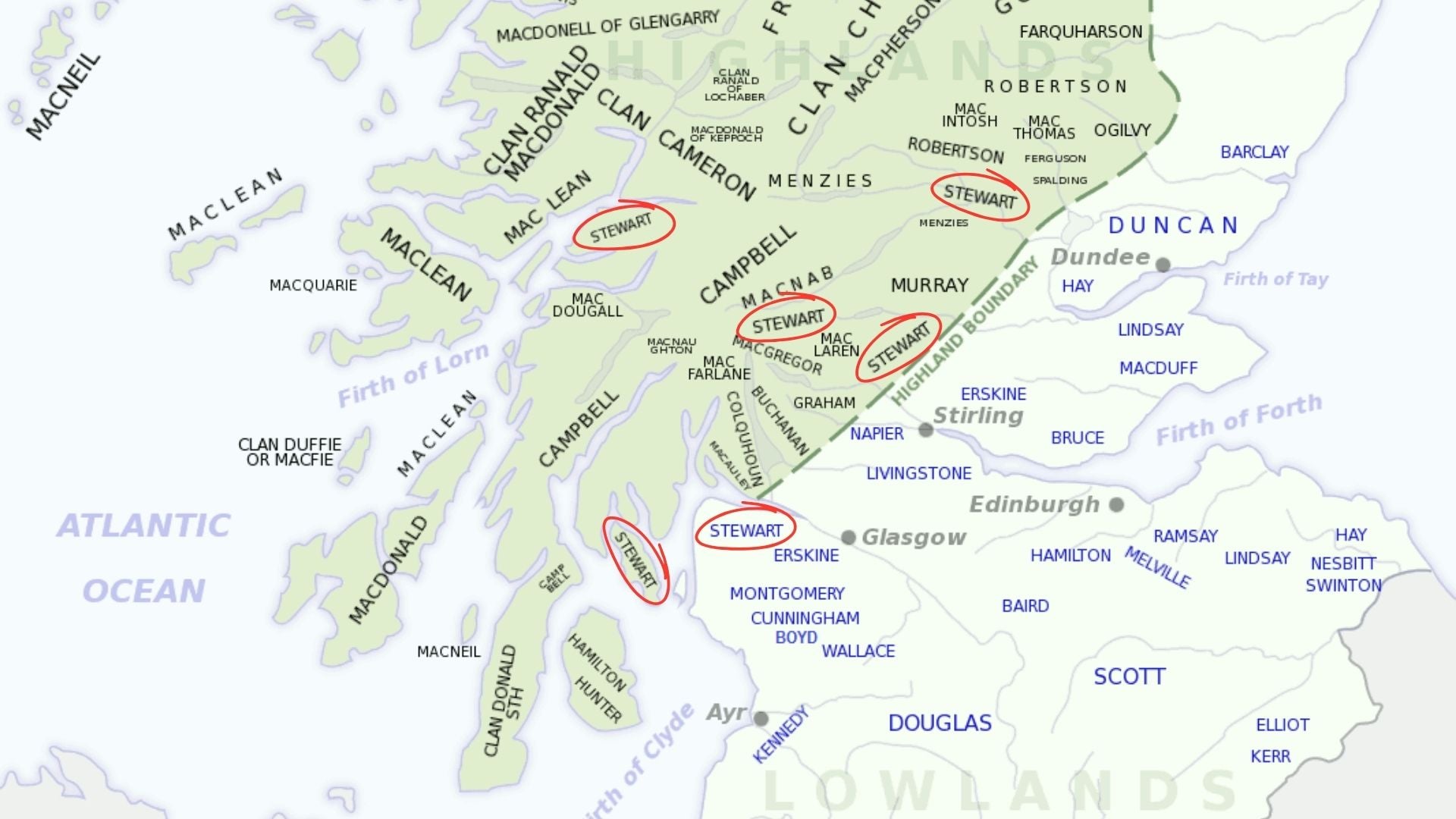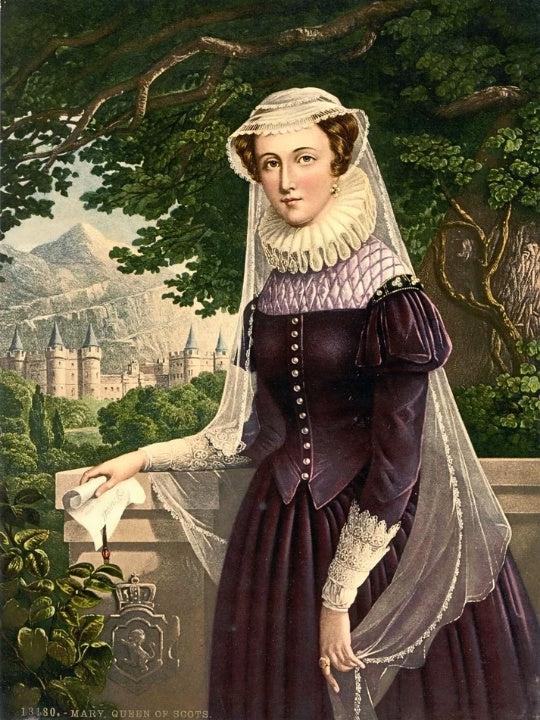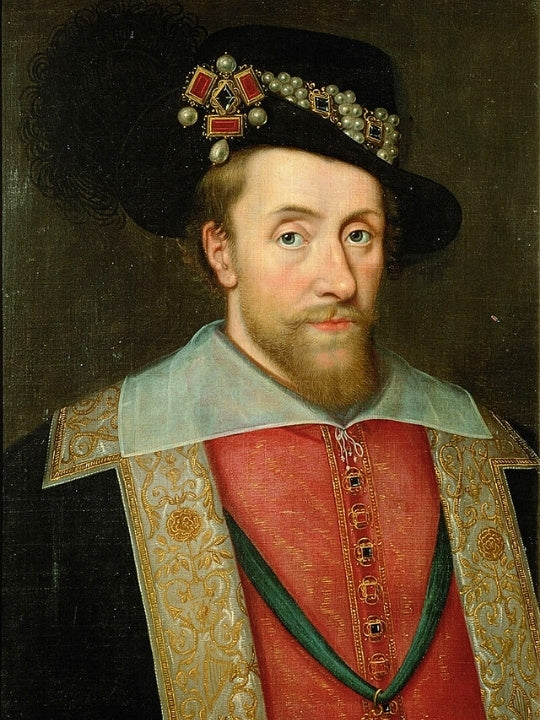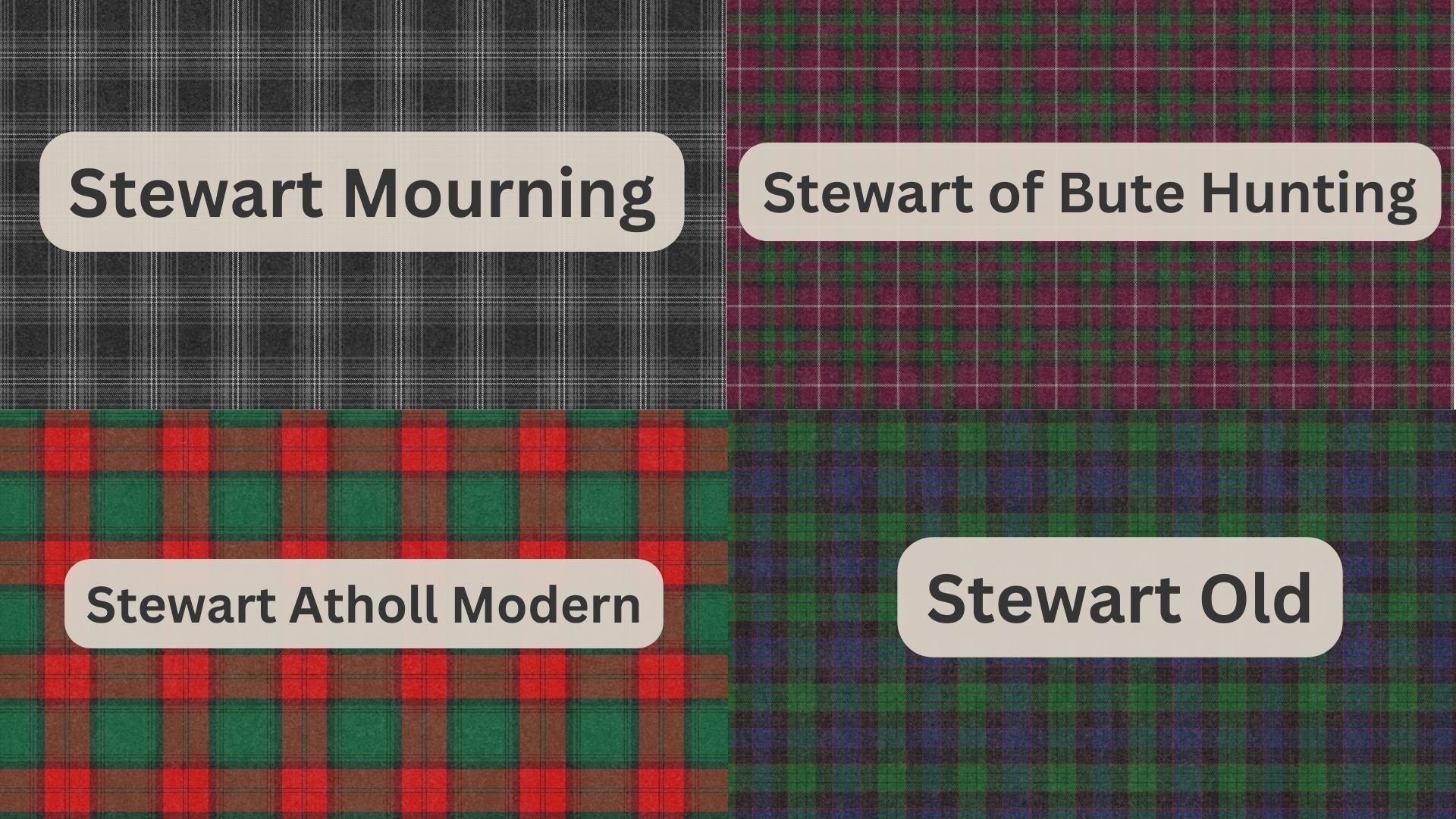Clan Stewart: Explore History, Tartans & Royal Bloodlines
by Teresa Finn on Jul 12, 2025
Table of Content
Have you ever wondered what it feels like to be part of a royal legacy? The Clan Stewart (or Clan Stuart) isn’t just one of the most prominent Scottish families—it’s a name that helped shape the very soul of Scotland and, later, Great Britain. From medieval battlefields to royal palaces, from Highland glens to London thrones, the Stewart Clan of Scotland has a story that echoes through time like the haunting notes of a Highland pipe.
Whether you're a history buff, a proud Stewart descendant, or just curious about Scotland’s most illustrious clan, let’s journey into the rich legacy, royal connections, fierce loyalty, and unmistakable style—yes, we’re looking at you, Stewart clan tartan —that define the clan known around the world.
Stewart Clan Crest, Motto, and Symbolism
Crest: Due to a lack of a chief, members sometimes use the badge belonging to the Earl of Galloway: A pelican Argent, winged Or, in her nest feeding her young, Proper.
Motto: Virescit vulnere virtus (Courage grows strong at a wound)
Region: Lowlands and Highlands
District: Renfrewshire, Teviotdale and Lauderdale.
Pipe music: Bratach Bhàn nan Stiùbhartach (The white banner of the Stewarts)
Plant badge: Thistle

Before we dive into history, let’s talk identity.
Although the Clan Stewart is now considered an armigerous clan — meaning it lacks a recognized chief — their visual symbols are still proudly worn. Today, many members use the badge of the Earls of Galloway, which features a pelican Argent, winged Or, in her nest feeding her young—a powerful symbol of self-sacrifice and protection.
Beneath this noble crest lies the stirring Stewart clan motto: "Virescit vulnere virtus", which translates to “Courage grows strong at a wound”. Isn’t that beautifully Scottish? It’s about resilience, loyalty, and the ability to rise again, no matter how deep the cut.
The Stewart Clan Crest Scotland continues to symbolize pride, especially among the diaspora who carry its meaning in tattoos, pendants, and even family crests above their fireplaces.
Origins of the Clan Stewart
Where did it all begin? The story of the Stewart family starts far from Scotland—in Dol, Brittany, where Alan, a Breton noble, served as hereditary steward. His descendants, the FitzAlans, eventually made their way to England after the Norman Conquest.
But the turning point came in 1124, when Walter FitzAlan followed David I of Scotland northward. There, he was appointed the first High Steward of Scotland —and with that title came vast lands in Renfrewshire and East Lothian.
It was from the title "steward" that the name Stewart evolved. Later, when part of the family moved to France, the spelling shifted to "Stuart" due to the lack of a “w” in French—a change that would stick when Mary, Queen of Scots brought it back to Scotland and made it fashionably royal.

History of the Stewart Clan
The Rise of the Royal Line (14th Century)
Once the Stewarts became firmly established in Scotland, they didn’t waste time climbing higher. Their rise reached a turning point when Walter Stewart, 6th High Steward of Scotland, married Marjory Bruce, daughter of King Robert the Bruce. This wasn’t just a smart marriage—it was the key that unlocked a throne.
Their son, Robert II, became the first Stewart king of Scotland in 1371. It was a moment that transformed the Stewart family from powerful nobles into the Royal Clan of Scotland. This dynasty would shape the future of the realm.

Intrigue Within the Bloodline: The Albany Challenge (15th Century)
While the Stewarts held the crown, not all of them played nicely.
The Albany Stewarts, a powerful branch descended from Robert II’s second son, Robert, Duke of Albany, began pulling strings behind the throne. For years, Albany acted as regent—essentially king in all but name—while the rightful monarch, James I, languished in captivity in England.
But James didn’t forget.
When he returned to Scotland in 1424, he swiftly moved against the Albany Stewarts. In 1425, Murdoch Stewart, Albany’s son, and his family were executed for treason. It was a brutal power play, but it reaffirmed that no one challenged the king. Not even blood.
Glory and Heartbreak: The Renaissance & Mary, Queen of Scots (16th Century)
Under the Stewart kings James IV and James V , Scotland flourished. They embraced learning, music, architecture, and diplomacy—ushering in a Scottish Renaissance.
But then came Mary, Queen of Scots . Mary’s reign is one of history’s most dramatic tales. Young, beautiful, Catholic in a Protestant land—her life was a political powder keg. She was imprisoned, forced to abdicate, and eventually executed by her cousin, Elizabeth I of England .
Yet even in death, Mary became an icon of loyalty, femininity, and tragedy. Her memory still haunts the halls of Holyrood Palace , and her legacy shaped the next generations.

The Union of the Crowns (17th Century)
Mary’s son, James VI of Scotland, would carry the Stewart name to new heights. In 1603, he became James I of England, uniting the two kingdoms under one crown for the first time. This was the dawn of Great Britain, and at its head stood a Stewart.
The 17th century, however, proved turbulent. The monarchy faced increasing resistance from Parliament, and religious tensions erupted. Under Charles I, conflict escalated into civil war. He was executed in 1649. His death shocked the world: a king brought low by his people, and a nation without peace.
His son, Charles II, was later restored to the throne, but the wounds were deep. The House of Stewart was no longer invincible.

The Last Stand: The Jacobite Rebellions (Late 17th–18th Century)
The final reigning Stewart monarch, James VII and II, was forced from the throne during the Glorious Revolution of 1688. His Catholicism made him deeply unpopular in Protestant Britain, and his flight to France marked the official end of Stewart rule.
But not all was lost.
His followers— the Jacobites —believed the true king had been wrongly deposed. They rose in 1715 and again in 1745, led by Charles Edward Stuart, better known as Bonnie Prince Charlie. Wearing his clan Stewart tartan, he inspired thousands to his cause.
But the dream died at Culloden. Outnumbered and outgunned, the Jacobite forces were crushed. In particular, the Clan Stewart of Appin suffered heavy losses, still commemorated today at the Clan Stewart of Appin Stone at Culloden.
It was the last stand for the Stewarts, but their story was far from over.

A Legacy That Lives On
Even without a throne, the Clan Stewart of Scotland remains one of the most storied in Europe. Their blood still runs through the veins of the modern British monarchy via Elizabeth Stuart, daughter of James VI. The current heir to the British throne carries the ancient Scottish title: Great Steward of Scotland.
The Royal House of Stewart (Stuart)
Yes, that’s right—the Clan Stewart became the House of Stuart, a royal line that ruled Scotland, England, and Ireland.
Famous monarchs like James IV, Mary, Queen of Scots, and James VI and I (who united the Scottish and English crowns in 1603) trace their bloodlines to the Stewarts. These were not ceremonial monarchs—they influenced everything from European diplomacy to religious reform and international politics.
Their downfall? Political conflict, religious tensions, and the fateful Jacobite uprisings of 1715 and 1745. But even after the royal line ended, the blood of the Scottish Stewart clan still flowed in European royalty. In fact, modern British monarchs are descendants of the Stewart line through Princess Elizabeth, daughter of James VI.

Major Branches of the Stewart Clan
The Stewart name branches far and wide, with each line adding its chapter to the clan's incredible legacy. Here are five of the most notable branches:
Clan Stewart of Appin: Descended from Sir John Stewart of Bonkyll, this Highland branch became fierce Jacobite warriors, fighting bravely at Culloden. Their loyalty to the Stuarts earned them a legendary place in Scottish history—and even a spot in literature through Kidnapped by Robert Louis Stevenson.
Clan Stewarts of Atholl: Rooted in the fiery legacy of Alexander Stewart, the “Wolf of Badenoch,” this line settled in Perthshire and produced the Atholl Highlanders, Europe’s only legal private army. Though later tied to the Murrays, many still proudly bore the Stewart name.
Clan Stewarts of Balquhidder: Established in the late 1400s, this peaceful southern Highland branch was closely tied to the story of Rob Roy MacGregor. They thrived in the glens and became a symbol of quiet Highland resilience.
Clan Stuarts of Bute: Born from an illegitimate royal line, the Stuarts of Bute became powerful nobles with strong ties to the British Crown. Their home, Mount Stuart House on the Isle of Bute, remains a jewel of Victorian architecture.
Clan Earls Castle Stewart (Ireland): A branch with deep royal bloodlines, Castle Stewart traces back to the Albany Stewarts and represents the clan’s expansion into Ireland. Their seat in County Tyrone connects Scottish heritage with Ulster’s complex past.
👉 Looking for authentic Royal Stewart or Appin tartan clothing? Browse our handpicked Stewart tartan apparel designed to honor your heritage with every thread.
Other notable branches include:
Clan Stewart of Stewart
Clan Stuart of Albany
Clan Stuart, Earl of Buchan
Clan Stewart of Barclye
Clan Stewart of Garlies
Clan Stewart of Minto
Clan Stewart of Physgill
Clan Stuart of Bute
Clan Clan Stuart, Earl of Moray
Clan Stewart of Rothesay
Clan Stewart, Earl of Carrick
Clan Stewart, Duke of Ross
Clan Stewart, Earl of Strathearn
Clan Stewart, Earl of Galloway
Clan Stuart of Darnley
Clan Stuart of Lennox
Clan Stewart of Ardvorlich
Clan Stuart, Lord Avandale
Clan Stuart, Lord Ochiltree
Clan Stewart Tartans and Their Variations
Ah yes—the tartan. No Scottish clan story is complete without its patterns woven into tradition.
For the Stewarts, tartan is more than just cloth—it’s identity, legacy, and pride stitched into every thread.
The Royal Stewart tartan is iconic and has long been associated with the royal household and regimental pipers. It became so popular that even King George V adopted it as his tartan—and today, it’s one of the most recognized tartans in the world.



Across centuries and regions, many variations of Stewart tartans have emerged, each with its own colorway and historical context. Here are some of the most well-known types:
Stewart Dress Tartan
Stewart Hunting Tartan
Clan Stewart Mourning Tartan
Clan Stewart Black Tartan
Stewart Black and White Tartan
Clan Stewart of Appin Tartan
Clan Stewart of Atholl Tartan
Stewart of Bute Hunting Tartan
Clan Stewart of Galloway Tartan
Clan Stewart Grey Tartan
Clan Stewart Muted Blue Tartan
Clan Stewart Navy Tartan
Clan Stewart Old Tartan
Clan Stewart Atholl Modern Tartan
Clan Stewart Royal Blue Tartan
Whether you’re tracing lineage or love the look, the Stewart clan plaid connects generations across time and place.

Lands and Castles of Clan Stewart
The Clan Stewart didn’t just leave a legacy in names—they left it in stone.
From Stirling Castle to Doune Castle, Linlithgow Palace, and the iconic Castle Stalker in Appin, these towering fortresses reflect the power and prestige the Stewarts once held.
Regions like Renfrewshire, Teviotdale, Lauderdale, Appin, and Bute were once Stewart strongholds. The Cormorant’s Rock (Creag an Sgairbh) still watches over Loch Linnhe, where the Appin branch stood tall, figuratively and literally.

Clan Stewart Today
So, where is the Clan Stewart now?
While there’s no single chief today, branches like the Earls of Galloway, Stuarts of Bute, and Stewarts of Appin still proudly lead their communities. Global Stewart societies gather for Highland Games, clan reunions, and heritage events that keep the flame of their heritage alive.
Thanks to modern DNA testing and ancestry tools, more people than ever are asking: “ Which Stewart clan am I from? ” It’s a question rooted in identity, culture, and pride.
The Stewart clan coat of arms, clan Stewart crest, and even Clan Stewart coats remain sought-after symbols by those reconnecting with their roots, whether in Scotland, North America, Australia, or beyond.
A Living Legacy of Power, Honor, and Heritage
The story of the Clan Stewart is one of rise, reign, and resilience. From humble Breton stewards to rulers of empires, from misty Highland glens to the heart of Westminster, their journey is the very definition of Scottish greatness.
But this isn’t just history—it’s legacy. A living, breathing identity that continues through names, traditions, symbols, and plaid. If you carry the Stewart name, wear the tartan, or feel drawn to their story, you’re part of something royal—something eternal.
So, next time you wear yourself in a Stewart Clan tartan clothing or visit Castle Stalker, remember: you’re not just honoring a name—you’re keeping history alive.
Frequently Asked Questions
Does the Stewart bloodline still exist?
Yes, the legitimate male-line descendant of Robert II is Andrew Richard Charles Stuart, 9th Earl Castle Stewart.
What is the Stewart clan known for?
Clan Stewart is known for producing many Scottish monarchs, including Mary, Queen of Scots, and founding the royal House of Stuart.
Is Stewart Irish or Scottish?
Stewart is a Scottish surname and clan, though some branches later settled in Ireland, especially Ulster.
What is the Clan Stewart's motto?
The Stewart clan motto is “Virescit vulnere virtus”, meaning “Courage grows strong at a wound”.
Which Stewart clan am I from?
Many branches include the Clan Stewart of Appin, Atholl, Balquhidder, and Stuart of Bute. Tracing your ancestry through family records or DNA tests can help determine your branch.
















